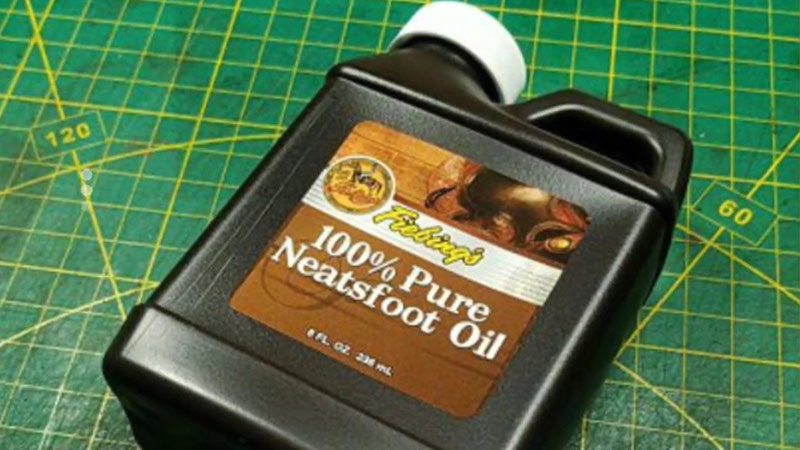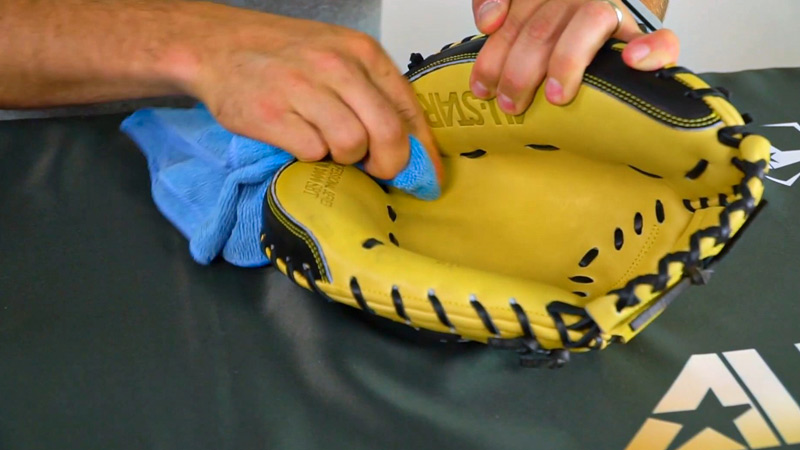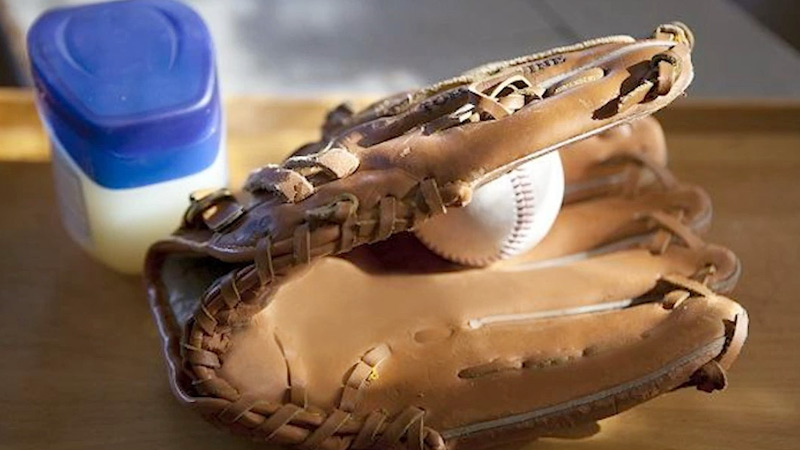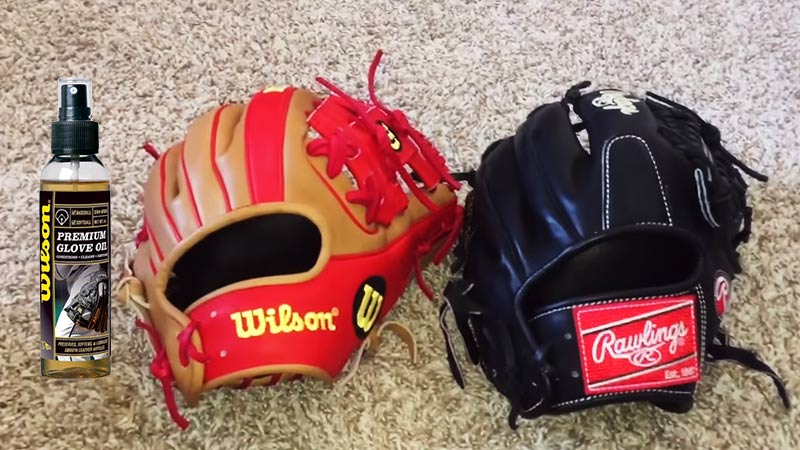Your baseball glove is more than just a piece of equipment; it’s an extension of your game. To keep it in peak form, you need to know how to properly condition it, and selecting the right oil is a crucial part of that process.
In this comprehensive guide, we’ll explore the world of baseball glove conditioning and delve into the various types of oils you can use to ensure your glove remains soft, supple, and ready for action.
We’ll discuss the benefits of glove oil, and the different options available, and provide expert tips on how to effectively apply the oil, so your glove can last through countless seasons of catches and fielding plays.
What Oil Can I Use on My Baseball Glove?
To keep your baseball gloves in the right condition, you should learn what oil to use on your baseball gloves.
You can use specially formulated glove oils such as Rawlings Glovolium or Wilson Pro Stock Glove Conditioner, which are designed to nourish and preserve the leather of your baseball glove.
These products are preferred because they are specifically crafted to maintain the glove’s suppleness without causing damage.
Alternatively, you can use natural oils like mink oil, lanolin, or even shaving cream. However, exercise caution when using these alternatives, as they may darken the leather or make it heavier.
When applying oil, clean your glove first, then use a soft cloth or sponge to spread a thin, even layer of oil on the leather. Make sure not to over-oil your glove, as excess oil can lead to a heavy, overly supple glove that doesn’t perform well.
Regular conditioning, proper storage, and cleaning routines will keep your baseball glove in top shape for a long time, enhancing your playing experience.
Understanding the Need for Glove Oil
Here are the facts you need to know about the baseball glove oil:
Preservation of Leather
Leather baseball gloves are prone to drying out and losing their natural oils over time. Glove oil is essential to replenish these lost oils, keeping the leather soft, and supple, and preventing it from becoming brittle or cracking.
Enhanced Flexibility
Regular use can make the glove stiff and less flexible. Applying glove oil restores the glove’s flexibility, allowing it to mold to your hand for a better fit and improved performance on the field.
Water Resistance
Glove oil helps create a protective barrier on the leather, making the glove more resistant to moisture. This ensures that your glove remains in good condition even when exposed to rain or damp playing conditions.
Durability
Conditioning your glove with oil extends its lifespan. Well-maintained gloves are less likely to suffer from wear and tear, reducing the need for frequent replacements.
Improved Catching and Gripping
A properly conditioned glove ensures a better grip on the ball and smoother catches. It can also help prevent the ball from bouncing out of the glove, making you a more reliable fielder or catcher.
Types of Oils Suitable for Baseball Gloves
There are several types of oils suitable for conditioning baseball gloves, each with its own advantages and considerations. Here’s an elaborate look at the various options:
Leather-Specific Oils

This is a popular choice among baseball players and is specifically designed for glove maintenance. It helps to keep the leather soft and supple, extending the glove’s lifespan.
Wilson Pro Stock Glove Conditioner: Wilson’s conditioner is another well-regarded product for glove care. It is formulated to rejuvenate the leather, preventing it from drying out and cracking.
These oils are specially designed for baseball gloves, so they are safe and effective for conditioning.
They help maintain the leather’s integrity and don’t cause excessive darkening or stiffness. Leather-specific oils can be more expensive compared to alternatives.
Natural Oils
Mink oil is a natural conditioner that is used for various leather products. It helps to moisturize and protect the leather, preventing it from drying out and cracking.
Lanolin is derived from sheep’s wool, and it’s known for its moisturizing properties. It can be used to condition leather, including baseball gloves.
Shaving Cream: Some players use non-gel, non-aerosol shaving cream as a budget-friendly alternative for glove conditioning.
These natural oils are cost-effective options for conditioning. They can provide adequate moisture and flexibility to the leather.
Natural oils may darken the leather, so they might not be suitable for players who prefer to maintain the original color of their gloves.
Overuse of some natural oils can make the glove heavy and overly supple, affecting performance.
Glove Manufacturers’ Recommended Oils
Some glove manufacturers offer their own conditioning products that are designed to work best with their specific glove models. These can be a good choice to ensure compatibility.
These oils are tailored for specific glove models and are less likely to cause any adverse effects. Using manufacturer-recommended products may even maintain warranty coverage on your glove.
When selecting an oil for your baseball glove, consider factors such as your budget, the specific care requirements of your glove, and your personal preferences regarding changes in the glove’s appearance and feel.
Regardless of the oil you choose, the key to effective glove conditioning lies in the proper application, ensuring that you don’t over-condition and that you follow a regular maintenance routine to keep your glove in peak playing condition.
How to Oil a Glove?

Oiling a baseball glove is an essential part of maintaining its condition and ensuring it remains flexible and durable. Here’s a step-by-step guide on how to oil a glove properly:
Materials You’ll Need
- Glove oil (leather-specific oil or a suitable alternative)
- Soft cloth or sponge
- A small container for the oil
- Optional: Baseball or softball to shape the pocket
Clean Your Glove
Before applying oil, make sure your glove is clean. Use a damp, clean cloth to remove any dirt or debris from the surface. This ensures that the oil can penetrate the leather effectively.
Prepare the Oil
Pour a small amount of glove oil into a container. You don’t need a lot; a little goes a long way. You can always add more if needed.
Apply Oil to the Glove
Dip the soft cloth or sponge into the oil, ensuring it’s lightly saturated but not dripping.
Begin by applying oil to the glove’s pocket, as this is the area that receives the most wear. Rub the oil onto the leather, focusing on the inside and outside of the pocket. Be thorough but avoid overdoing it. A thin, even layer is ideal.
Continue to apply oil to the other parts of the glove, such as the webbing, fingers, and the back of the glove. Pay attention to any areas that appear dry or are prone to cracking.
Spread the Oil Evenly
After applying the oil, use the cloth to spread it evenly across the leather. Make sure there are no excessive oil spots. The goal is to achieve a consistent, light coat.
Shape the Pocket (Optional)
If you want to deepen or reshape the pocket of your glove, place a baseball or softball in the pocket and secure it with a rubber band or string. This will help mold the glove while it dries.
Allow the Glove to Dry
Leave the glove in a cool, dry place to allow the oil to penetrate and the leather to absorb it. This can take several hours or even a day, depending on the oil and the climate. Be patient; don’t rush the process.
Check and Reapply as Needed
Once the glove has dried, inspect it to see if it has absorbed the oil evenly. If some areas appear dry or if you want to further deepen the pocket, you can repeat the oiling process.
Remove Excess Oil
If there’s any excess oil on the surface after drying, gently wipe it off with a clean, dry cloth.
Test the Glove
Before using the glove in a game or practice, give it a few catches to help break it in and ensure it feels comfortable and flexible.
Regularly oiling your baseball glove, especially after prolonged use or exposure to wet conditions, will help maintain its quality and extend its lifespan.
Proper conditioning can make your glove feel like an extension of your hand and improve your performance on the field.
Tips for Effective Apply of Oil Baseball Glove

Applying oil to your baseball glove effectively is crucial to maintaining its condition and performance. Here are some tips to ensure you apply glove oil effectively:
Use the Right Oil
Choose a high-quality glove oil that is specifically designed for baseball gloves. These oils are formulated to protect and condition the leather without causing any adverse effects.
Clean the Glove First
Before applying oil, make sure your glove is clean. Wipe off any dirt or debris with a damp cloth. Clean leather absorbs oil better, ensuring a more even application.
Warm the Glove
If the leather is particularly stiff, you can warm the glove slightly by leaving it in the sun or using a hairdryer on low heat. This makes the leather more receptive to the oil.
Apply Thin Layers
Apply the oil sparingly. A little goes a long way. Use a soft cloth or sponge to spread a thin, even layer of oil. Avoid drenching the glove, as excess oil can make the glove heavy and less effective.
Focus on the Pocket
Start by applying oil to the pocket of the glove, which experiences the most wear. Work the oil into the leather, both on the inside and outside of the pocket. The pocket is where you want the most flexibility and suppleness.
Pay Attention to Key Areas
Apply oil to other critical areas, such as the webbing, fingers, and the back of the glove. These areas can also dry out and benefit from conditioning.
Spread Oil Evenly
After applying the oil, use the cloth to spread it evenly across the leather. Make sure there are no excessive oil spots. Even distribution ensures consistent conditioning.
Shape the Glove
If you want to shape the pocket or reshape it, place a baseball or softball in the pocket and secure it with a rubber band or string while the glove dries.
Allow for Proper Drying
Leave the glove in a cool, dry place to allow the oil to penetrate and the leather to absorb it. Be patient; this process may take several hours or even a day.
Inspect and Reapply as Needed
After the glove has dried, check if it absorbed the oil evenly. If any areas appear dry, you can reapply the oil specifically to those spots.
Maintain Regularly
Make glove conditioning a part of your regular maintenance routine. How often you condition your glove depends on its usage and exposure to various conditions, so adjust as needed.
By following these tips, you can effectively apply oil to your baseball glove, keeping it in great condition and ready for top performance on the field.
How to Choose the Right Oil for Baseball Glove
Certainly! Here are some essential tips for effectively applying oil to your baseball glove:
- Choose the Right Glove Oil: Use a high-quality glove oil specifically designed for baseball gloves. These products are formulated to nourish and protect the leather without causing damage.
- Start with a Clean Glove: Before applying oil, clean your glove with a damp cloth to remove any dirt, debris, or sweat. Clean leather will absorb the oil more effectively.
- Warm the Glove: If your glove is stiff, you can warm it slightly to make the leather more receptive to the oil. You can leave it in the sun or use a hairdryer on low heat for a few minutes.
- Apply Thin, Even Layers: Less is more. Apply a small amount of oil to a soft cloth or sponge and rub it onto the leather. Start with thin, even layers, and gradually build up if needed. Avoid over-saturation.
- Focus on the Pocket: Concentrate on the pocket of the glove, as it experiences the most wear and tear. Work the oil into the pocket, both inside and out, to maintain flexibility and suppleness.
- Address Key Areas: Apply oil to other critical areas such as the webbing, fingers, and the back of the glove. These areas can dry out and benefit from conditioning.
- Evenly Distribute the Oil: Use a cloth or sponge to spread the oil evenly across the leather. Ensure there are no excess oil spots. Even distribution promotes consistent conditioning.
- Inspect and Reapply as Needed: After the glove has dried, check for any dry spots or areas that need more conditioning. You can reapply oil specifically to those spots if necessary.
- Remove Excess Oil: If there is any excess oil on the surface after drying, gently wipe it off with a clean, dry cloth. This ensures your glove is not overly oily.
- Test the Glove: Before using it in a game or practice, give the glove a few catches to ensure it feels comfortable and flexible. This also helps break it in further.
By following these tips, you can effectively apply oil to your baseball glove, preserving its condition, maintaining its flexibility, and enhancing its performance on the field.
FAQs
What kind of oil for baseball glove?
The best kind of oil for a baseball glove is glove oil specifically designed for the purpose. Leather-specific oils like Rawlings Glovolium or Wilson Pro Stock Glove Conditioner are popular choices.
Natural oils like mink oil, lanolin, or even non-gel shaving cream can also be used, but they may darken the leather or make it heavier.
What oil for a baseball glove?
When choosing an oil for your baseball glove, you can use leather-specific glove oils, which are ideal for glove maintenance. Alternatively, natural oils like mink oil or lanolin can be used.
It’s important to use oils that won’t harm the leather and will help maintain its flexibility and durability.
What oil to use for a baseball glove?
The type of oil to use for a baseball glove depends on your preference. You can choose leather-specific glove oils for the best results, or opt for natural alternatives like mink oil or lanolin.
The key is to select an oil that conditions the leather without causing damage and to apply it properly.
What is the best oil for a baseball glove?
The best oil for a baseball glove is typically a leather-specific glove oil, such as Rawlings Glovolium or Wilson Pro Stock Glove Conditioner.
These products are designed to condition and protect the leather without causing harm.
However, some players also prefer natural alternatives like mink oil. The choice ultimately depends on your glove’s specific needs and your personal preferences.
Wrapping Up
In the world of baseball, your glove is your most trusted companion on the field. By choosing the right oil and applying it effectively, you can prolong its life and maximize its performance.
Whether you opt for leather-specific oils or natural alternatives, your glove’s longevity and comfort are in your hands.
Remember, proper conditioning is an investment in your game, and with regular care, your glove will continue to help you make those crucial catches and plays for many seasons to come.
So, get out there, condition your glove, and get ready to shine on the baseball diamond.







